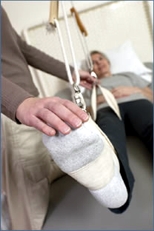
Every 30 seconds, a lower limb is lost due to diabetes-related complications. That comes to 2,880 legs and feet every day.Diabetes is an epidemic of national proportions, and currently affects nearly 24 million Americans. It is also a family affair, as the disease is commonly passed down from parents to children. Unfortunately, many people with diabetes--and those at risk for the disease--do not discuss its hereditary nature and negative physical effects with members of their family. APMA's 2009 diabetes campaign, Diabetes is a Family Affair (DIAFA), encourages those with the disease to begin having this important discussion! Early detection and treatment of complications from diabetes, such as foot ulcers, is important to treating the disease successfully and avoiding a foot or leg amputation.
In addition, the 2009 DIAFA campaign focuses on the African-American community. Ethnicity plays a large factor in a person’s risk for developing diabetes, and African-Americans are nearly twice as likely to develop the disease as Caucasian-Americans. Treating the disease requires proper education, understanding, a trusting relationship between the patient and diabetes management team, and support from family and community. ____________________________
An estimated 25 percent of people with diabetes will develop serious wounds on
Courtesy: APMA (Amercican Podiatric Medical Association) |
|
|
Dr. Phillip DeCubellis Dr. Jason Evans |
|
|
|
|
|
|
|
|
|
|
|
|
|
|
|

© South Florida Podiatry Group, 2009-2010. All Rights
Reserved.
Home Toenail Problems Heel Pain Athlete's Foot Heel Fissures-Cracked Heels Diabetic Care Corns And Calluses Foot Warts Bunions About Us Our Services Footprints Newsletter Press-Releases Articles Resources Contact Us Maps & Directions Privacy Policy Site Map
 DIABETES
DIABETES 